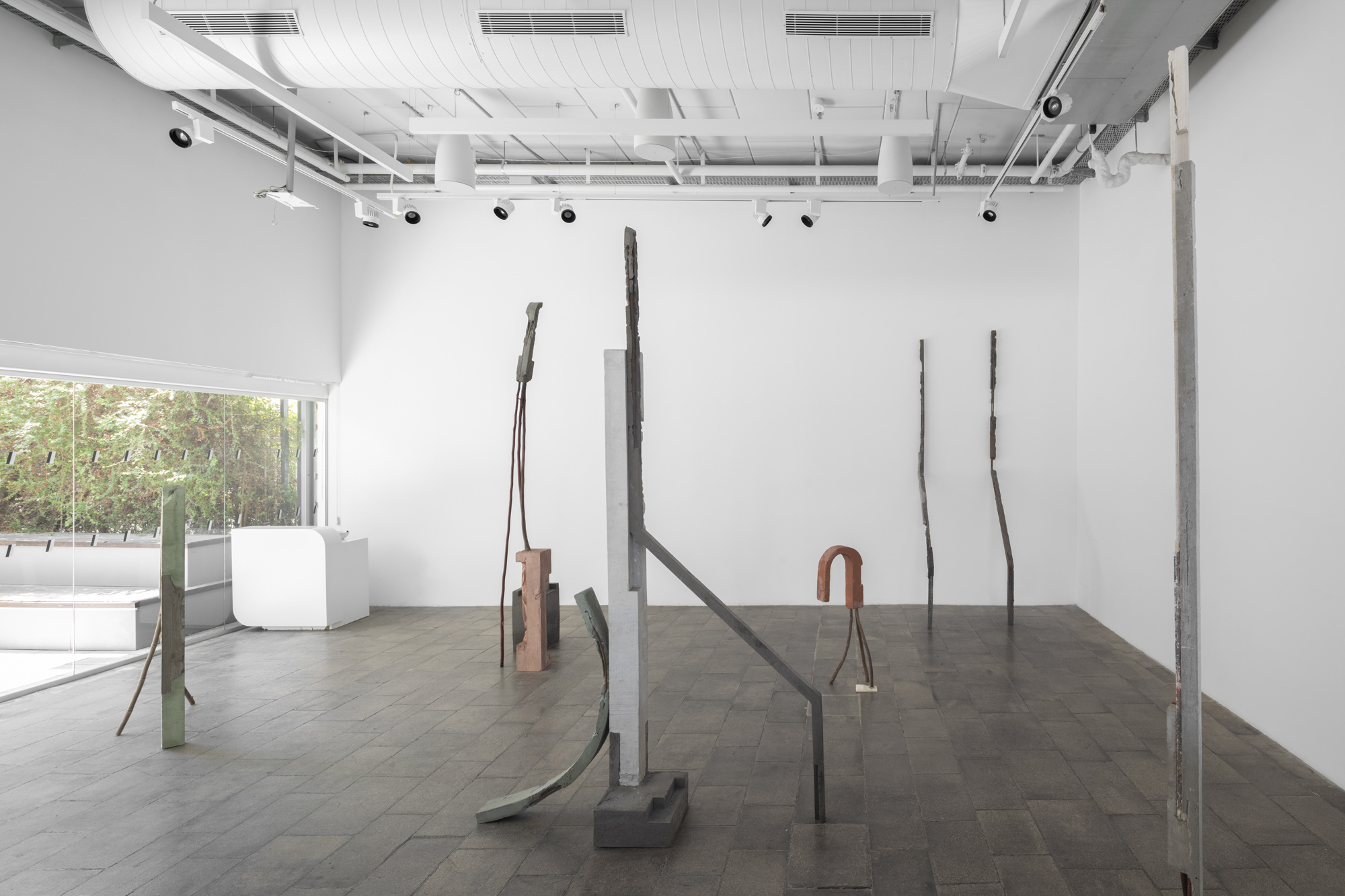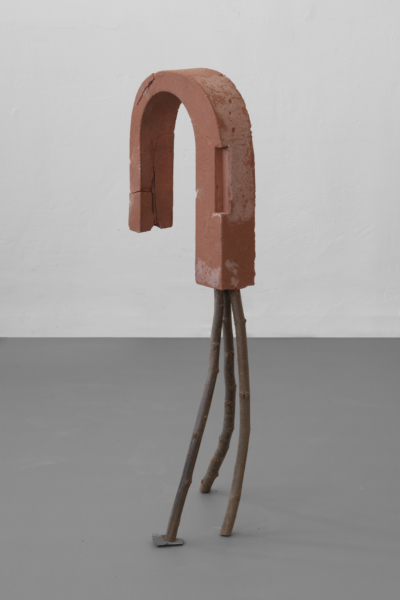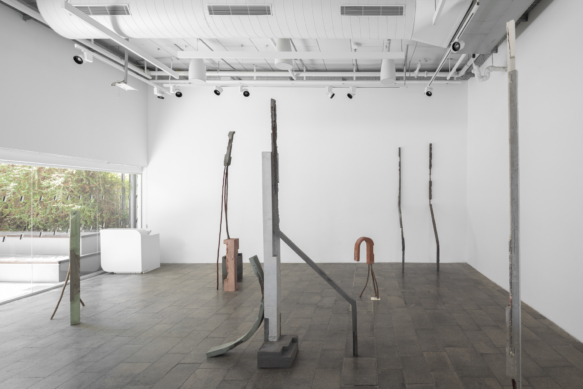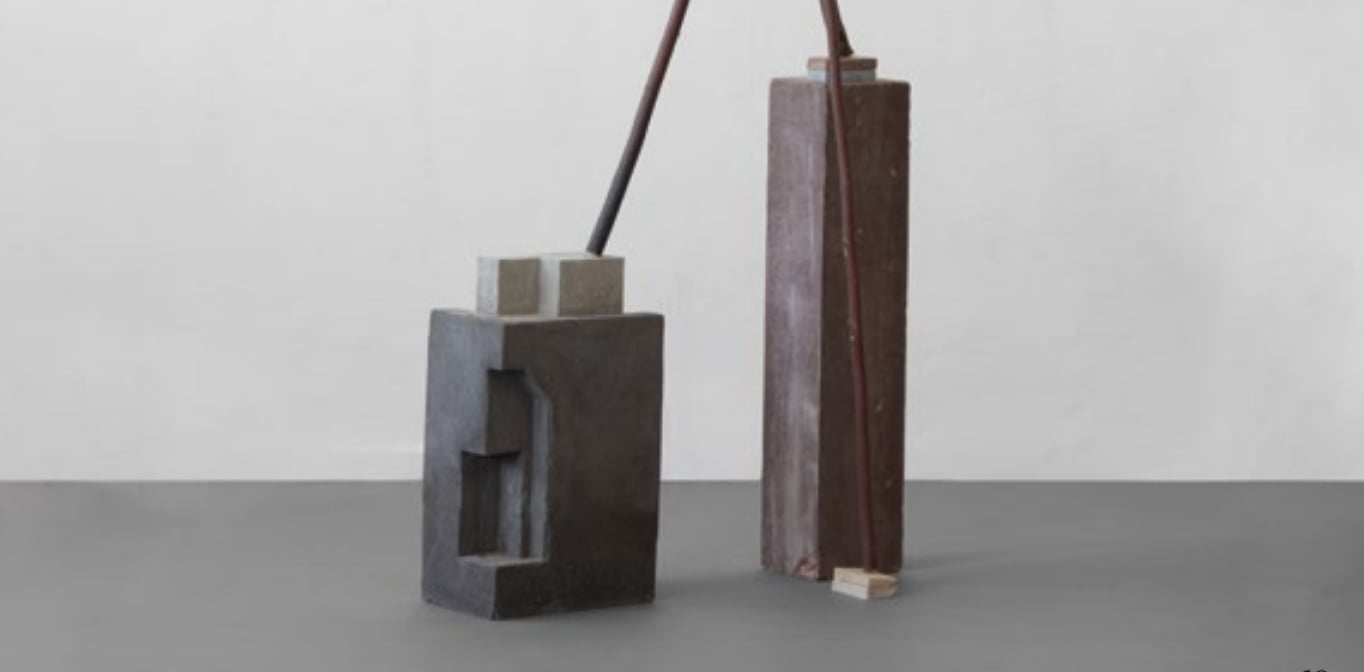The walls in Netai Halup’s studio are high, towering upward in off white, with drill holes here and there. Scarce furniture dot the paint-stained old terrazzo flooring: a table, shelves laden with iron rods. The north wall boasts large windows, and in the morning the sun bathes the studio with dazzling light, that grows brighter during the day. There is one office chair that rolls through the different sections of the studio, and in the middle—an empty space.
The empty space assumes alternating roles. One moment it is a construction site: dirty wooden molds stand in the center, ready for casting; sacks of cement are poured into a black tub, buckets of water are mixed in, iron rebar and pigments are introduced to the concrete mix, formulas are scattered on sheets of paper, weights are calculated. In another moment it is an archive: geometric concrete objects-bodies in pastel shades are taken off the shelves, sorted into series, and lined on the floor. And under a different light, the studio takes on the appearance of a rehearsal room, just before the curtain rises: an object at the far end of the space is lifted and moved to the center; an adjacent object leans against another similar object, probing its grip; one element climbs high on another unit; a concrete square placed on Persian lilac-wood legs exercises stability; a coin balances a swinging rectangle.
In the initial dialogue between Halup and his bodies of work, the artist plays the role of creator. He creates them from scratch, drawing and planning their form and structure, connecting materials and quantities via internal movement. Flexibility is an important component in the work’s construction, but his practice is underlain by the knowledge that if miscalculated, the body will not be able to bear its elements and form. To release life from the material, the dosages must be accurate, but also surprising.
In the earliest story, the first man was composed of a corporeal substance—dust, and all the literary characters thereafter started as raw materials and received the spirit of life from their human creators: in the synagogue’s attic, a rabbi sculpts a golem in clay using holy letters; in the carpentry workshop, an old man carves a child in wood; in an old boarding house, a doctor mixes body parts and chemicals to create a monster.
By the same token, Halup creates familiar geometric elements characterized by heavy materiality, and only later, once installed, does he breathe life into them. The concrete, which is associated with weight, non-elasticity, and massiveness, masquerades, acquiring lightness and a sense of hovering in the gallery space. Bathed in soft, delicate colors, it is inspired by harmony and calm alongside tension stemming from its installation mode. The sculptures surrender living features from the very first glance: they are slender, rising upward nobly. Delicate and vulnerable, they seek comfort in each other. They are shy, modest, and somewhat submissive, appearing to be on the verge of collapsing, ostensibly striving to merge with the gallery’s existing floor tiles.
In her poetic approach, and specifically in the dance piece Figure a Sea, choreographer Deborah Hay lets the dancers manage their own movement spaces. Spending a long period of time together in the studio, she constructs the shell, creates the necessary conditions, defines the boundaries, and infuses them with her diverse dimensions and qualities. When the dancers take the stage, the body embarks on a quest of self-reflection, moving in the space naturally, like a flowing, independent entity. Asking “what if?,” Hay enables the dancers, as well as the work as a whole, to transform into a sea of countless possibilities. The learning process and separation from the choreographer spawn real freedom, furnishing viewers with the ability to observe a spectrum of transient, synchronous instances, meeting points, and connections that hold an element of surprise for her too.
The concrete works featured in And Other Stories likewise generate a dance of human artistry. The sculptural creatures scattered in the gallery space, charged with the DNA of the creator who breathes life into them, rise against their maker and embark on a new path, independent of their origin, engaging in their own dialogue and collectivity. Assuming that anything is possible and the works will embark on their independent path in any event, all that is left for Halup is to take his place as yet another body in the cluster of bodies he has created. He is no longer the parent watching from above, but rather plays an active role in the newly-created world. He moves the bodies and orchestrates various scenarios that become stand-alone paradigms. It is a dynamic space of interactions: his creatures seek a foothold on the gallery walls and floor; they lean against one another and support each other. Each combination of several sculptures generates a new story, which may change in the next scenario, depending on the dancers, the time, place, and space. Even if we wanted to stop the story-dance, it would be impossible because it is endless.
Although movement depends on a space of time, taking place and slipping away elusively, Halup sensitively freezes the fraction of a second in which the action occurs. At the same time, with the help of the viewer who wanders around the gallery, encircling the sculpture, orientation changes and the static body gains continuity. Halup thus lightens the heavy cast sculpture abruptly, expanding the sculptural mechanism and allowing it to be spontaneous and active.
In an anthology of short stories, the story which gives its name to the whole volume is not necessarily the most important one. Equipped with a profound understanding and an emotional connection with the material and the potential inherent in it, Halup gives us a glimpse of the simple, minor stories through the material. He confronts us with the need for the other, for the necessity of fragility and cracks, demonstrating separation alongside containment, and allowing us to imagine the next act.
Read More








